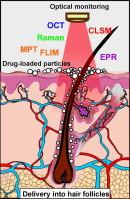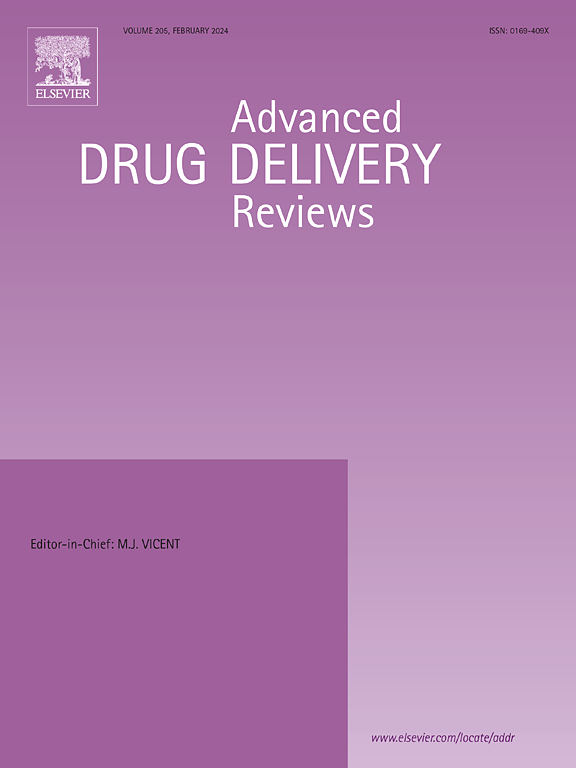毛囊给药光学监测的现状
IF 17.6
1区 医学
Q1 PHARMACOLOGY & PHARMACY
引用次数: 0
摘要
通过毛囊给药已经引起了许多研究的关注,因为它具有局部和全身治疗的潜力。最近对各种颗粒制剂局部应用的研究表明,这种递送途径对于靶向位于皮肤中的众多细胞群并将封装的药物分子运送到血液中具有重要作用。尽管针对卵泡的载体有很大的前景,但它们的临床应用非常罕见,主要是因为与传统的外用剂型(如软膏和面霜)相比,它们的特性较差,而传统的外用剂型已有一个多世纪的历史。收集尽可能完整的信息,了解这些载体的微囊内渗透深度、储存、降解/代谢特征,以及它们所含药物的释放动力学,以及它们对皮肤健康的影响,将大大有助于了解每种载体类型的优缺点,并有助于选择最合适的临床试验候选者。光学成像和光谱技术被广泛应用于研究药物的皮肤渗透。目前的论文提供了最先进的技术概述,这是用于光学监测卵泡药物输送,特别侧重于非侵入性体内方法。讨论了它们的主要特点、优点和局限性,并就该领域的未来发展方向提供了专家的观点。本文章由计算机程序翻译,如有差异,请以英文原文为准。


Current issues in optical monitoring of drug delivery via hair follicles
Drug delivery via hair follicles has attracted much research attention due to its potential to serve for both local and systemic therapeutic purposes. Recent studies on topical application of various particulate formulations have demonstrated a great role of this delivery route for targeting numerous cell populations located in skin and transporting the encapsulated drug molecules to the bloodstream. Despite a great promise of follicle-targeting carriers, their clinical implementation is very rare, mostly because of their poorer characterization compared to conventional topical dosage forms, such as ointments and creams, which have a history spanning over a century. Gathering as complete information as possible on the intrafollicular penetration depth, storage, degradation/metabolization profiles of such carriers and the release kinetics of drugs they contain, as well as their impact on skin health would significantly contribute to understanding the pros and cons of each carrier type and facilitate the selection of the most suitable candidates for clinical trials. Optical imaging and spectroscopic techniques are extensively applied to study dermal penetration of drugs. Current paper provides the state-of-the-art overview of techniques, which are used in optical monitoring of follicular drug delivery, with a special focus on non-invasive in vivo methods. It discusses key features, advantages and limitations of their use, as well as provide expert perspectives on future directions in this field.
求助全文
通过发布文献求助,成功后即可免费获取论文全文。
去求助
来源期刊
CiteScore
28.10
自引率
5.00%
发文量
294
审稿时长
15.1 weeks
期刊介绍:
The aim of the Journal is to provide a forum for the critical analysis of advanced drug and gene delivery systems and their applications in human and veterinary medicine. The Journal has a broad scope, covering the key issues for effective drug and gene delivery, from administration to site-specific delivery.
In general, the Journal publishes review articles in a Theme Issue format. Each Theme Issue provides a comprehensive and critical examination of current and emerging research on the design and development of advanced drug and gene delivery systems and their application to experimental and clinical therapeutics. The goal is to illustrate the pivotal role of a multidisciplinary approach to modern drug delivery, encompassing the application of sound biological and physicochemical principles to the engineering of drug delivery systems to meet the therapeutic need at hand. Importantly the Editorial Team of ADDR asks that the authors effectively window the extensive volume of literature, pick the important contributions and explain their importance, produce a forward looking identification of the challenges facing the field and produce a Conclusions section with expert recommendations to address the issues.

 求助内容:
求助内容: 应助结果提醒方式:
应助结果提醒方式:


